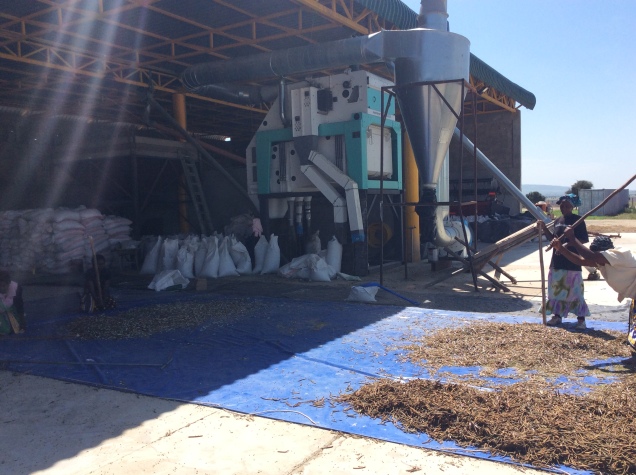Today Gordon and I split up. Don’t worry we haven’t fallen out but opportunities for seeing chicken for Gordon and large scale arable came up for me which were miles apart so we couldn’t visit both together. While Gordon was in the police station I was been driven down the farm track to Stuart’s farm.

It’s not often you seen Giraffe on the way to a visit

I also saw Wildebeest, Gazelle, Zebra, Ostrich and Wart Hog. Unfortunately the cheetahs and lions were hiding. The reason for driving down this track is because Stuart’s farm is at the other end. Stuart Barden is a 2009 Australian Nuffield Scholar who when he was travelling through Kenya on his travels was given some soil maps and was asked “if you could farm here where would it be?” Stuart pointed at the fertile Black Cotton Soil near Athi River.
 Then 3 yrs later was here and breaking new ground in Kenya. A bold decision for anyone. The first two years were particularly tough. Stuart planted grain sorghum and unfortunately it was decimated by Red Weaver Birds. The birds caused one million dollars worth or damage in the first two years. This meant he had to sell the rest of the farm in Australia to keep farming in Kenya and so he had no fall back. As he said it sharpened his mind as it now had to work.
Then 3 yrs later was here and breaking new ground in Kenya. A bold decision for anyone. The first two years were particularly tough. Stuart planted grain sorghum and unfortunately it was decimated by Red Weaver Birds. The birds caused one million dollars worth or damage in the first two years. This meant he had to sell the rest of the farm in Australia to keep farming in Kenya and so he had no fall back. As he said it sharpened his mind as it now had to work.
The limiting factor here on this farm is moisture, he only gets 500mm per year. So Stuart’ is no till, CTF and is trying to build up residue cover.

This field was mung beans last year and will go into wheat next week. This ground three years ago was reserve and now is a 650 ish hectare field. He only has two fields with a rotation of two legumes and then a cereal. As this is virgin ground Nitrogen is not limiting. When planting a cereal be uses only 70-80kgs of total product, which is a blend of MAP, Potassium Sulphate and Tiger 70 with traces. The organic matter is 3.8% and is walks beautifully. Stuart is very aware that he needs to maintain SOM and not mine this ground of it’s natural fertility. He has spent a lot of money on roads, water supply and fencing. The fencing maintenance is an almost full time job to keep the animals out. It is electric and turned on only when he has a crop planted.
Back at the yard Stuart has built the main building himself

This is probably the biggest tractor I have seen so far in Kenya

Stuart has 3 full time employees and one apprentice. When we were there they were building bulk hoppers

Nothing comes in bulk in Kenya. So to speed up filling the drill he is building hoppers which can be loaded ready while the drill is working. The grills are over the top because the seed and inputs can come with contamination e.g. String. The supply of seed is a real problem. Last year he grew barley which had a lot of impurities in it and was going to cost $100,000 in claims at the malsters. So he bought a cleaner for $50,000

He then cleaned it three times to get it to 99% purity. Now with seed he will plant a small area, then make sure it is clean at harvest and farm save from that area for the next year.
For chickpeas he was using an air reel on his combine which I had never seen before

Stuart didn’t have any fancy new machinery which was great to see

After the farm tour we had lunch and discussed some of Stuart’s plans and new ideas. He sees many opportunities even though there are huge challenges. He has a real pioneering “can do ” spirit but also wants to give back to the community. Since being in Kenya he has had over a thousand visitors from all over and Stuart spends the time with them trying to help them on their own farms.
Today was a great visit. Thanks Stuart and good luck!